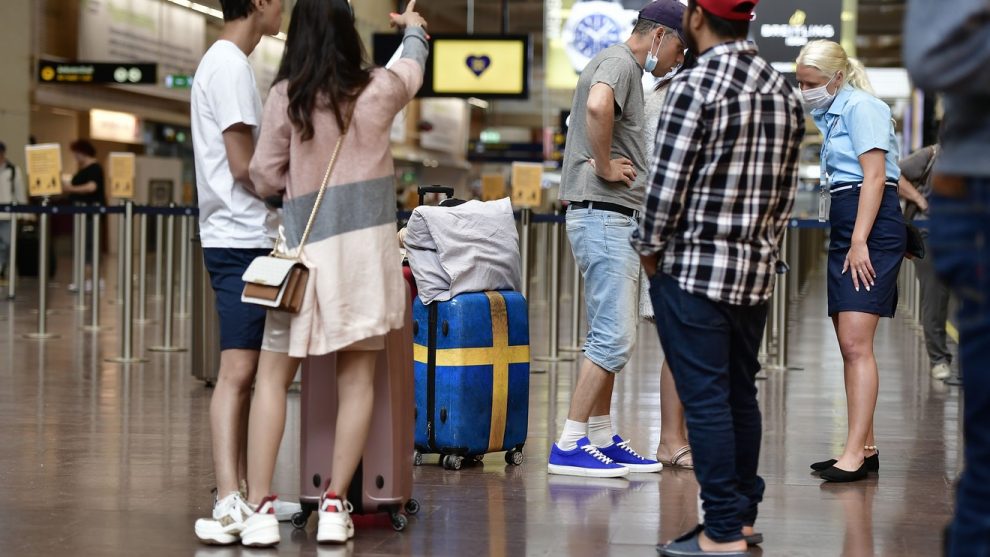
Leading Swedish health experts claim the country has a falling coronavirus infection rate because it was one of the few that didn’t go into lockdown and has rejected the need for masks.
Arne Elofsson, a professor in biometrics at Stockholm University, thinks the population has developed a form of immunity: “Strict rules do not work as people seem to break them. Sweden is doing fine.”
Anders Tegnell, an epidemiologist involved in managing Sweden’s pandemic response (the Financial Times called him its architect), thinks masks give a false sense of security: “The belief that masks can solve our problem is very dangerous.”
Prime Minister Stefan Löfven thinks voluntary social-distancing rules and not closing schools but banning gatherings of more than 50 people has been the right approach: “Now there are quite a few people who think we were right,” he told a newspaper. “The strategy that we adopted, I believe is right — to protect individuals, limit the spread of the infection.”
Data from the European Centre for Disease Prevention and Control show Sweden has a fortnightly infection rate of 37 cases per 100,000 people. This is much lower than France, with 60 cases per 100,000 and Spain at 152.7 cases per 100,000.
However, Sweden has an overall COVID-related death rate of 57.05 per 100,000, which is the ninth highest in the world, according to Johns Hopkins University. What’s more, Sweden, which has a population of just over 10 million, has had a fatality rate of 6.8%; that’s lower than those of Belgium, the U.K., Italy and Spain, but higher than the fatality rates of Brazil, the U.S., Mexico, France and Ireland.
The U.K. considered a herd-immunity approach in the early stages of the pandemic but ultimately decided against it and opted for a lockdown instead.
Supporters of Sweden’s strategy say it’s better to allow immunity to build up among members of the population who are least at risk of dying from COVID-19, thereby reducing the rate of transmission and protecting those who are most at risk of dying from COVID-19, the disease caused by the coronavirus SARS-CoV-2.
That’s the theory. It would, if carried out perfectly, help countries manage the spread of the virus without overwhelming hospitals with sick people, while also mitigating the full economic impact of closing down public areas, canceling major events and introducing travel bans.
In its effort to reach herd immunity while minimizing economic damage, Sweden, critics say, failed to protect its elderly population, who make up the majority of those who died from COVID-19 there. Another chink in its herd-immunity approach: Sweden only banned care-home visits at the end of March.
“We failed to protect our elderly,” Lena Hallengren, Sweden’s health and social-affairs minister, told Swedish Television earlier this summer. “That’s really serious, and a failure for society as a whole. We have to learn from this; we’re not done with this pandemic yet.”
Sweden reported its highest death tally in 150 years in the first half of this year, the country’s official statistics office said this month.
Experts around the world cannot agree on what the right approach is to opening up schools, scaling back lockdowns or even the wearing of masks. Sweden reported that 86,068 people have contracted the coronavirus since the pandemic began, according to Johns Hopkins University, Sweden’s approach has also come at a cost, having seen 5,810 deaths from COVID-19, a much higher toll than its neighbors’.
Ultimately, enough people would need to be immune to shield the most vulnerable to take a herd-immunity approach.
“With influenza, you need herd immunity of 60% to 70%. With measles, you need about 95%. With COVID-19, it’s somewhere in the middle,” Gregory Poland, who studies the immunogenetics of vaccine response in adults and children at the Mayo Clinic in Rochester, Minn., and expert with the Infectious Diseases Society of America, previously told MarketWatch.
A Word from the Experts:University of Minnesota epidemiologist Michael Osterholm: Americans will be living with the coronavirus for decades
In an interview with the Observer newspaper in London this month, Tegnell, the Swedish epidemiologist, claimed that up to 30% of the country’s population could be immune to COVID-19. “It’s very difficult to draw a good sample from the population, because, obviously, the level of immunity differs enormously between different age groups between different parts of Stockholm and so on, and that’s why when we measure one group we get 4% to 5%, and when we measure another group they’re up to 25%,” he said.
In the absence of a vaccine, Mayo’s Poland said several conditions are necessary for herd immunity to work: a very high level of population immunity, for that immunity to be durable, and for the virus to not mutate.
Critics say even Tegnell’s most optimistic forecasts for Sweden are still a long way from the 60% to 70% goal required for herd immunity to have a chance at working, and save the lives of the elderly and those with underlying conditions — those most vulnerable members of the population.
Coronavirus daily update:WHO says plasma treatment touted as breakthrough by Trump is unproven, advises caution











Add Comment